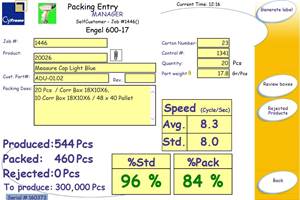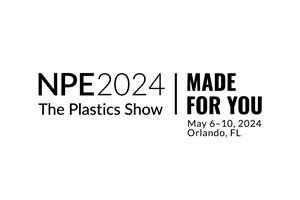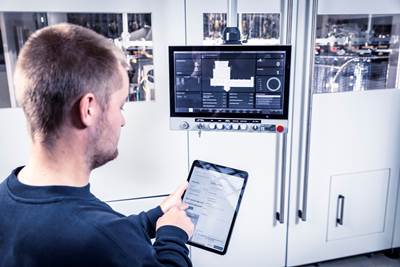Is There a Better Way to Heat PET Preforms for Stretch-Blow Molding?
Is near-infrared (NIR) heating better, faster and more energy efficient? So far, only two machine builders are making such claims for NIR in place of standard mid-infrared preform heating, though their systems appear to be well accepted. Meanwhile, an altogether different alternative is in the works.
Productivity and energy efficiency are two major drivers of technical developments in stretch-blow molding (SBM) and other plastics processes. Near-infrared (NIR), a variant of standard infrared (IR) heating, is said to offer both desired benefits but may not be well known among PET container makers. NIR heating has been commercially available since 2010 but from only two of 14 makers of two-stage PET stretch-blow molding machinery (not counting almost two dozen more builders of such machines in China). Sales of these systems are said to be doing well, however.
Why have so few machine builders adopted this technology to date? How well has NIR heating been accepted by customers, and does their experience confirm claims of faster and more energy-efficient preform heating? Answers to these questions from a handful of OEMs and molders offer some clarity. Furthermore, one machine builder has a heating system in development that may soon challenge all forms of IR preform heating in two-stage SBM.
What Is NIR & Why Is It Different?
“Near” infrared is so named because it is the portion of the IR spectrum closer to the visible range of light frequencies. Depending on whose definition you use, NIR frequencies span wavelengths of approximately 714 nanometers (nm) to 2,500 nm. Conventional mid-IR used in preform heating ranges from 2,500 to at least 25,000 nm. The maximum IR transmission rate of PET is said to be from 400 to 1600 nm. Thus, more of the NIR spectrum falls within the range in which PET tends most to transmit rather than absorb the radiation. Why this is important will be explained below.

Compared with standard mid-IR radiation used for PET preform heating, NIR spectrum is shifted left toward shorter IR wavelengths. Thus, more of the energy-emission curve is in the region of maximum PET transmission (400-1,600 nm), allowing deeper penetration of NIR into the preform without being absorbed near its outer surface. Source: KHW
Note that definitions may vary. One OEM explains that conventional IR lamps for preform heating are best described as in a range between NIR and mid-IR, and their maximum emission range may not be that different from NIR lamps — though that depends on the color temperature at which the lamps are operated.
KHS, a German builder of large, rotary SBM systems, introduced NIR heating on its Blomax IV machines in 2010. NIR is standard on the succeeding generation, Blomax V, where it’s offered in conventional single-lane or optional dual-lane ovens. The benefits of NIR heating are one of the company’s main selling points, and the technology has been “widely accepted since 2010,” according to Product Manager Jim Chow.
NIR penetrates farther into the preform than mid-IR, avoiding overheating of the outer surface and providing more uniform heating throughout.
The only other known supplier of NIR heating for PET SBM is of Austria. NIR was introduced on the company’s APF-Max series of linear, all-electric two-stage machines, which was launched in 2016. The company has sold more than 50 of these machines, and demand is growing by 50% annually, largely due to their energy savings, says Tetiana Pronikova, head of marketing.
KHS and PET Technologies agree on how and why NIR heating differs in performance from the usual mid-IR heating, as shown in the accompanying graphic from KHS. “NIR supplies more energy in the range of shorter wavelengths (peak shifted to the left), where PET has a lower absorption rate,” Chow explains. “Thus, more radiation can progress deeper into the material before it heats up the PET by absorption.
As a result, the preform wall down to the inner surface heats up more quickly, without overheating the outer preform surface — which therefore does not require air cooling — and leads to reduced heating times and more even heating with less temperature gradient through the preform.” Ultimately, this means more efficient heating, he says, with lower overall energy usage and better conditions for stretch blowing. For example, tests by KHS under similar conditions showed that when the preform outer surface reached 77°C, the inner surface reached 68°C under NIR, but was at 59°C under mid-IR.

PET Technologies is one of two OEMs featuring NIR preform heating as standard on its two-stage SBM systems. Source: PET Technologies
PET Technologies’ Pronikova concurs: “Reduced absorption intensity in the NIR range allows the radiation to penetrate PET preforms more deeply and uniformly compared with mid-IR radiation. This allows energy to be distributed throughout the preform volume rather than being concentrated on the surface. NIR’s ability to penetrate deeper ensures a more uniform temperature distribution between the inner and outer layers of the preform wall.”
She adds that a more uniform temperature profile is especially important in processing recycled PET (rPET), because “rPET requires higher processing temperatures due to molecular changes during recycling,” which necessitate “precise thermal control.” PET Technologies says this combination of speed and control is likewise particularly valuable in processing asymmetric PET bottles, refillable/returnable bottles, hot-fill bottles and colored bottles.
Three benefits are said to result with NIR:
- Faster heating: “Studies highlight that NIR technology achieves near instantaneous heating compared with mid-IR systems, which require longer exposure times,” Pronikova says. Notes Chow: “We have seen heating-time reduction up to 50%.”
- Energy savings: “NIR heating systems consume less energy because they minimize heat loss through convective cooling and focus energy directly into the material,” Pronikova says. “This translates into significant energy savings — up to 35% in some cases.” Adds Chow: “When we compared strictly between NIR and mid-IR in our Blomax III versus current Blomax V machines, we have found up to 40% energy savings are possible with NIR and the newest oven design.” He notes that a further 30% savings are possible by switching from a conventional single-lane to a dual-lane oven.
- Shorter ovens: “Faster heating enabled by NIR allows for design of shorter ovens in SBM machines,” Pronikova notes. “These compact systems save space on production floors and are easier to transport. Compact NIR ovens also require less power to operate.” Chow says that up to 50% faster heating means ovens can be up to 50% shorter.
What Do Customers Say?
Recipientes y Empaques de Mexico SA de CV (REMSA) has two generations of PET Technologies’ SBM machines: third-generation APF series in two sizes and one model in the fourth-generation APF-Max series with NIR heating. The company uses these machines for applications such as thick-walled PET bottles for wines and spirits. These heavier containers also have asymmetrical shapes.
REMSA has an APF-3002 and APF-Max 2, both with two cavities for bottles up to 2 liters. While the output of the APF-3002 with mid-IR heating is 3,000 bottles per hour (bph), the APF-Max 2 reaches 3,300 bph due to the energy-efficient NIR heating system, according to a REMSA source. Also, the shorter NIR oven makes the APF-Max 2 shorter overall by 1 meter than the earlier APF-3002 model. Both types of machines offer the flexibility to process REMSA’s more than 20 different PET bottle designs.
PET Technologies introduced NIR heating as standard on its APF-Max series of all-electric, two-stage SBM systems in 2016. Source: PET Technologies
Chow says that several KHS customers have conducted apples-to-apples comparisons of machines with and without NIR heating — using the same preform, material and production speed — and confirmed that the Blomax with NIR saves energy.
Why Don’t More Machine Builders Use NIR Heating?
In Pronikova’s view, “The limited adoption of NIR heating by machine suppliers can be attributed to the cost of implementation. NIR heating systems generally require specialized equipment, including high-temperature NIR lamps and precise control systems, which can increase the upfront cost of the machinery compared with traditional mid-IR systems. Development and integration of NIR-compatible systems into existing production lines may involve significant reengineering, which adds to capital expenditures.”
Chow had no comment about other OEMs’ thinking on NIR, but he did say, “We do not see significant difference in the cost of the heaters between NIR and mid-IR.”
One OEM that does not use NIR is Krones AG, a German maker of large rotary SBM systems. Jochen Forsthoevel in Krones’ product management for plastics technology does not see significant heating and energy advantages from NIR heating. He notes that the emission spectra of NIR and mid-IR heaters “are not far apart,” and “the exact location of the emission maximum is as very dependent on the power with which you operate the emitter (oven output process adjustments). In practical use, all lamps that are used by the big suppliers for preform heating perform very similarly, whether NIR or not.”

KHS has offered NIR heating on its Blomax IV and V systems since 2010. Its dual-lane oven option shown here multiplies the energy savings attainable with NIR. Source: KHS GmbH/Reinhold Images
He further notes that NIR heating technology for preforms “was initially marketed with polished metal mirrors for high reflection.” These reflectors have two disadvantages, he claims: “the necessity to clean them often and the unintentional heat profiling of the preform that can result from contaminated reflector surfaces, which can deteriorate the bottle performance and process stability. Thus, they are probably not used so often anymore.” Standard IR heating modules, he explains, uses ceramic reflectors that are “more or less self-cleaning and create a slightly more blurred heating profile that has shown to be more practical in most cases. Our experience is that a low heating-energy consumption with a big process window for preforms with different wall thicknesses is easiest to achieve with an oven that uses standard quartz lamps and a mainly ceramic reflector on the other side of the preform.” (Chow of KHS notes that his firm uses ceramic, rather than metal, reflectors in its NIR ovens.)
What’s Coming Next?
“To get a step change in heating efficiency,” says Krones’ Forsthoevel, “NIR is not the way to go. In our opinion, microwave could be a promising candidate.” Krones previewed microwave preform heating in a prototype system at K 2010. The FlexWave oven for its Contiform SBM machine reportedly used up to 50% less energy than conventional IR ovens. “Thanks to the very short heating time, the number of preforms inside the oven has been reduced to a fraction of the former figure, resulting in very low preform losses in the event of an emergency stop,” Krones claimed at the time. Heat-up time was said to be only about 3 seconds, or up to 80% shorter than IR ovens. The exceptionally high penetration depth of microwave radiation reportedly enables the preform to be evenly warmed without need for surface cooling or an equilibration time. “No other technology is able to combine very deep penetration, energy density and heating speed in this way,” Krones concluded.
Microwave heating is said to be unaffected by preform color or proportion of recyclate.
Each FlexWave microwave station was fitted with an enclosed cavity resonator. The ability to control each station separately reportedly offers unprecedented process flexibility. What’s more, microwave heating is said to be unaffected by the preform color, initial temperature, grade of PET or proportion of recyclate.
Forsthoevel hints that Krones may be able to show the next evolution of the FlexWave system at the next Drinktec show, Sept. 15-19, 2025, in Munich, Germany.
Related Content
Use Interactive Production Scheduling to Improve Your Plant's Efficiencies
When evaluating ERP solutions, consider the power of interactive production scheduling to effectively plan and allocate primary and secondary equipment, materials and resources on the overall production capacity of the ´óĎó´«Ă˝ and conclude that this is a key area that cannot be overlooked.
Read MoreProcessing Megatrends Drive New Product Developments at NPE2024
It’s all about sustainability and the circular economy, and it will be on display in Orlando across all the major processes. But there will be plenty to see in automation, AI and machine learning as well.
Read MorePolyJohn Turns to Blow Molding, Doubles Its Productivity
Leading maker of portable sanitation products knew thermoforming, sheet extrusion, rotomolding and injection molding. Then it found the missing link to higher productivity and new markets: blow molding.
Read MoreBlow Molder with a Mission: CKS Packaging Shares Gains Of Its Phenomenal Growth
From three machines in 1986 to 27 plants nationwide today, this family-owned processor has prospered through unwavering customer service, committed employees and dedicated service to its community.
Read MoreRead Next
Custom Molder Pivots When States Squelch Thriving Single-Use Bottle Business
Currier Plastics had a major stake in small hotel amenity bottles until state legislators banned them. Here’s how Currier adapted to that challenge.
Read MoreFor Extrusion and Injection-Blow Molders, Numerous Upgrades in Machines and Services
Uniloy is revising its machinery lines across the board and strengthening after-sales services in tooling maintenance, spare parts and tech service.
Read MoreAdding Remote Service Functions for PET Bottle Blowing
KHS has added features to its internet machine communications portal for PET stretch-blow molding.
Read More













